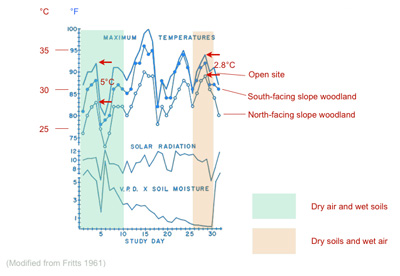3. Environmental and Ecosystem 'Noise'Spatial heterogeneity is a functional component in ecosystems and not just noise (Legendre, 1993). In plants this applies at all scales from biomes to variations in leaf form within a single tree crown and even to differences in tissue architecture, vascularization, fluid flow and diffusion pathways within leaves. Such heterogeneity is part of the spectrum of adaptation strategies that optimize fitness. In foliar physiognomic proxies this will appear, inevitably, as variations in character scores, particularly as evolution in angiosperms has resulted in selection for genomes that deliver high levels of leaf phenotypic plasticity. In CLAMP scoring attempts to capture the full range of morphologies displayed within a species at a given site and embraces the heterogeneity that is part of ecosystem function, even though this means that correlations are not as precise as one would wish for. Such variability is, after all, likely to be present in fossil leaf assemblages. Because often the parent plant of a fossil leaf is unknown Wolfe (1993) chose to sample all woody taxa (herbs seldom shed their leaves and thus herb leaves are only rarely found as fossils) spanning all growth forms (trees, shrubs, vines etc.). Exclusion of any of these growth forms gives rise to error (Burnham et al., 2001). Within this spectrum of growth habit leaves from exposed sunny environments and shady sub-canopy settings are included, again because a leaf's origin with the crown/canopy cannot be routinely determined from a fossil. This sampling strategy does of course mean that CLAMP includes leaves from a wide range of microclimates experienced within the crown and canopy space. Although these microclimates track the external (free air) environment measured by meteorological stations (Fritts, 1961) they tend to be cooler and more moist than the free air due to evapotranspiration. Most of the leaves sampled in CLAMP, whether living or fossil, are derived from the cooler more humid canopy and sub-canopy environments, but include both north and south facing slopes (Spicer and Wolfe, 1987). Because CLAMP calibrations include ‘outgroup’ samples from open dry vegetation (in order to better position some moisture-related vectors) it does mean that some closed canopy samples with high soil moisture and under dry air masses will appear, at least seasonally (depending on the climate), significantly cooler than ‘observed’ meteorological data. For an exploration of this phenomenon see Spicer et al. (2011).
A similar depression of temperature estimates and spatial heterogeneity in leaf architecture was noted by Burnham et al. (2001) when examining LMA based MAT estimates derived from river or lakeside vegetation. Again the datasets used for deriving LMA regressions are not confined to wetland vegetation and so we expect to see a similar underestimation of temperature. However, unlike CLAMP, which delivers average temperatures of the warmest month (WMMT) and coldest month (CMMT) as well as wet and dry season precipitation estimates, it is more difficult with LMA to detect when this effect comes into play and determine its magnitude. A common source of ecosystem 'noise' that does not apply to fossils is human disturbance. This is now ubiquitous and there is a not a single vegetation type in the world that has not been directly or indirectly affected by human activity. Ideally CLAMP samples should be collected from natural or naturalised vegetation but this is not always possible. As the CLAMP database grows we can afford to be more selective and will increasingly focus on minimally disturbed vegetation. |
||||||
 |
Uncertainties (in CLAMP and other climate proxies) |
Overview |
Taphonomic |
Climatic |
Environmental |
Sampling & Scoring |
CLAMP Stats. |


